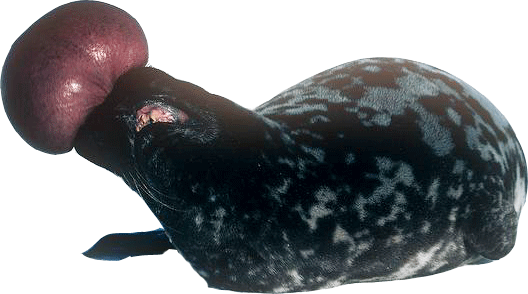Hooded Seal

Scientific Classification
Kingdom: AnimaliaPhylum: Chordata
Class: Mammalia
Order: Cetacea
Family: Phocoenidae
Genus: Cystophora
Species: cristata
Description
Adult hooded seals have black heads and silver-gray coats with dark blotches of different sizes and shapes across their bodies. Pups are called "blue-backs" for their coat of blue-gray on their backs and whitish bellies; this coat is hut after 14 months of age when they molt.
The hooded seal is unique for the elastic bi-lobed nasal cavity, or "hood", that adult males can blow up and extend from the front of their face to the top of their head. Sexually mature males also have an elastic nasal septum, which, when inflated, look like a pinkish red balloon, to attract females' attention through mating season and to display hostility towards other males.
Size
Adult males determine around 8 feet (2.5 m) long and weigh about 660 pounds (300 kg). Adult females are obviously smaller, measuring around 7 feet (2.2 m) in length and weighing about 440 pounds (200 kg).
Diet
Hooded seals typically dive for food to depths of about 325-1,950 feet (100-600 m) for 15 minutes, but have been found to dive to above 3,280 feet (1000 m) for up to an hour each time. Adult hooded seals feed on squid, starfish, mussels, and fish such as Greenland halibut, redfish, cod, capelin, and herring.
Habitat
Hooded seals live on traveling pack ice and in deep waters. Some drift far away from their northern habitat towards much warmer regions every year, but they live best in colder climates, as heat and constant sun exposure is damaging to them.
Distribution
Hooded seals live in the Arctic Ocean and the North Atlantic.
The four main breeding and molting grounds are:
- Gulf of St. Lawrence,
- off the coast of Newfoundland and Labrador,
- Davis Strait, an
- Norwegian Sea, near Jan Mayen Island (Folkow & Blix, 1995).
Population Trends
In 2005, surveys were conducted to assess population sizes in the main hooded seal habitats. The predictable number of hooded seal pups was 15,200 in Greenland and 116,900 in the Northwest Atlantic (ICES, 2006). Using this data, the entire population of hooded seals was predictable to be 592,100.
 Deep Sea Crabs
Deep Sea Crabs